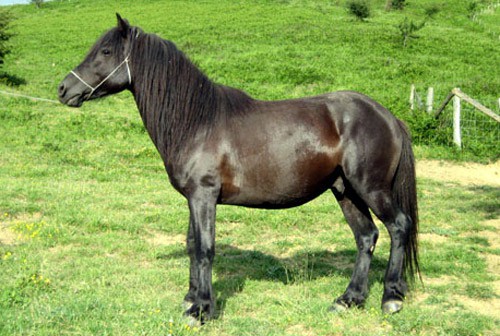Type the name of the breed you're looking for below
[wpdreams_ajaxsearchlite] Don't see the breed your're looking for? Click here and let us know!
Pottok pony
| Country Of Origin | France, Spain |
| History and Background | Also called Basque and Pottoka, the Pottok Ponies are left to live wild in the Pyrenees of the Basque Country in Spain and France. The last Wednesday of January they are rounded up, their numbers cut for market and the remaining animals are branded, then released again. Many opinions exist on the origins of the Pottok. It is deemed by the scientific community to have lived in the area for at least several thousand years. It displays signs of genetic isolation and is genetically closest to breeds like the Asturcón, the Losino, the Galician, the Landais, and the Monchino horses. Tests have revealed considerable genetic differences between populations in the Northern Basque Country and the Southern Basque Country, leading some to consider them separate breeds. Some claim the Pottok's origins derive from the horses on ancient cave paintings in the area and thus claim to descend from the Magdalenian horses of 14,000-7000 BC. Other link its origins to an influx of horses during the Bronze Age. However, neither of these theories has to date been scientifically verified. Genetic research by the University of the Basque Country's Genetics, Physical Anthropology and Animal Physiology department into various genetic markers amongst the 4 indigenous horse breeds in the Basque Country have examined their relationship to other horses. Based on microsatellite tests, of the four Basque horse breeds, the Pottok and the Basque Mountain Horse, are genetically the most distant from other breeds. The others, the Burguete horse and the Jaca Navarra (today considered meat breeds), less so. This variability in the Pottok and the Basque Mountain Horse appears to be related to the fact males mate range more widely and mate with more females in these feral or semi-feral herds. Research into a known single-nucleotide polymorphism showed this non-native alternation is very rare in purebred Pottoks. Tests of mitochondrial DNA revealed Pottoks are most likely to crossbreed with the Basque Mountain Horses, less so with other breeds. Although some genetic markers of other European horse breeds were found, overall the genetic distance to the other European breeds is large. Interestingly, one marker previously only found in certain British breeds has also been found in Pottoks. |
| Use Today | Performing ponies, Competition pony, Riding pony |
| Height | 11 to 14 hands high (44-56 inches, 112-142 centimeters) |
| Colour | Bay, Black, Pinto |
| Characteristics | The winter fur (borra) is one of the key characteristics of the Pottok and can reach up to 10 centimetres (3.9 in) in length on young horses. The archetypal coat colorations are in bay range with no patterning, but today various shades of brown and black exist in Pottok herds. Pottok pintos first appeared in Biscay in the 1850s and have spread to parts of Navarre and Labourd since. There are noticeable differences between mountain herds of Pottok and valley or flatland herds, with mountain horses generally being smaller. The official French breed standard distinguishes two types, the Pottok de Montagne or Mountain Pottok, with a height range of 1.15–1.32 m (11.1–13.0 h), and the larger Pottok de Prairie or Plains Pottok, which has a height range of 1.20–1.47 m (11.3–14.2 h). The Government of Biscay carried out research into some 250 horses of the Pottok population of Biscay, both wild and stabled, in 1996-97. The census revealed that the majority of semi-feral Pottoks in Biscay live in the far northwest of the province, in the Encartaciones. These semi-feral herds are rounded up twice a year, once in March before birthing and once in October after weaning. The survey also concluded that the main characteristics of the Biscayan population were: Black or blackish coats dominating (73%), followed by bays with (19%) Height range 1.15 to 1.30 metres (11.1 to 12.3 h), average height 1.256 m (12.1 h) Long, slim legs with black hooves Large, heavy heads A heavy winter coat (the borra) |
| Personality and Temperament | Docile and kind Willing and even-tempered |
| Other Considerations | Etymology; Pottoka is the Basque language name for this horse, both north and south of the mountains. In Upper Navarrese, potto and pottoka are generic terms for colts and young horses whereas in Lapurdian and Lower Navarrese the meaning of pottoka is "pony". Ultimately the name is linked to words such as pottolo "chubby, tubby". In French sources, the spelling Pottok predominates. In English, both Pottoka and Pottok are encountered but the term Basque Pony can occasionally also be encountered. |



